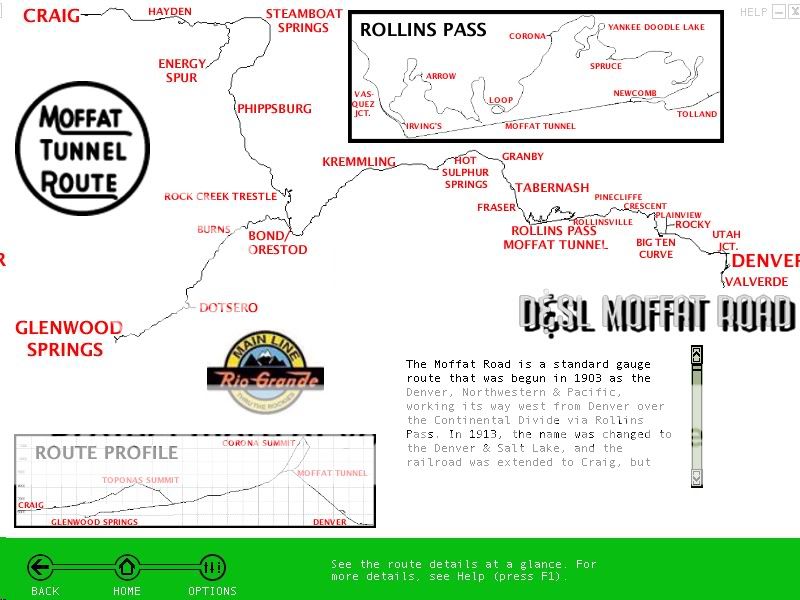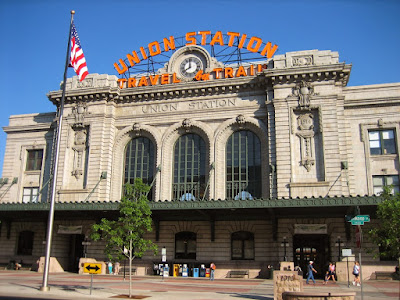So, I've seen the pass go from solid Rio Grande, to Rio Grande/Southern Pacific to Southern Pacific/Union Pacific and to silence.
The western side of the pass begins at Minturn. Minturn is a helper town just west of Vail. Vail is now rapidly growing into Minturn. To the west, is the Eagle River valley, and a number of local industries that would be nice to include in any model. These towns run all the way to Dotsero, where the Moffat line joins up.
East of Minturn, the line begins a climb with grades of up to 3%! Trains with 8, 10, 12 or even more units climbed this grade. No wonder that UP retired the line. The initial part of the line slips through a canyon, past the now abandoned New Jersey Zinc Mine (and Superfund site) located with Belden siding, and the little town of Red Cliff, before climbing out of the canyon at Pando. At Pando, we have another passing track, and then Dean or Pando Tunnel. Finally, the train makes its last assault on the pass with the Mitchell Curves before reaching the summit tunnel.
Helpers usually ran on through the tunnel and were cut off at Tennessee Pass siding, or Malta siding on the other side of the pass. They might run back light, or swing onto another train struggling to surmount the 10,000 foot pass. Malta siding is also the connection to Leadville, or at least it was, along with a connection to an isolated piece of Colorado and Southern trackage (operated by the Burlington Northern) that ran up to the Climax mine, high on Fremont Pass.
Continuing East from Malta, the line follows the Arkansas River, through towns such as Buena Vista, Nathrop and Salida. The line passes through the scenic Brown Canyon, past a beautiful bridge near Princeton siding (which begs to be modeled) and along the Collegiate Peaks of Colorado. Salida was once a division point, and was where the Standard Gauge and the Narrow Gauge met. IT was out of Salida that the Narrow Gauge 3rd Division left for Utah. But alas, the Narrow Gauge was removed, although the Monarch Branch was standard gauged and ran into the 1980s. This branch was unique on the Rio Grande, with a pair of switchbacks. Its operation is fascinating, and the subject of more than one book and video. Clearly, railfans loved the line.
East of Salida, the railroad works through another canyon, passes sidings such as Spikebuck, Texas Creek, and Parkdale, before plunging through the Royal Gorge. Within the Gorge, you have the hanging bridge, but otherwise, scenes only scene by the white water rafters, or riders of the railroad.
The railroad emerges in Canon City. The stretch from Canon City to Pueblo is itself interesting. The Santa Fe had some access along this stretch to provide service to customers. There are switching opportunities in Canon City, Florence, and Portland. Portland hosts a major cement industry. In addition, there is an Gypsum Wallboard plant along the line. Before entering Pueblo, the line transverses some interesting and unique scenery as the climate becomes much more of a dry high plains topography.
Pueblo itself is a major endeavor, with local industries, multiple rail yards, junctions between the Joint Line to Denver, the line south to Walsenburg and La Veta Pass, as well as Trinidad and Raton Pass. East, the Rio Grande operated the MP line to Kansas and ultimately to Saint Louis. The Santa Fe, Missouri Pacific and Burlington Northern both came into Pueblo. There is even a fantastic, iconic passenger station. Also of interest, just south or Pueblo is the Minnequa (Colorado Fuel and Iron) Steel Mill, which even boasted a narrow gauge plant railway at one point. There are several power plants nearby, and north of Pueblo is Fort Carson if you like military trains.
All in all, the subdivision runs about 230 miles. It is a lot of railroad. The grades on the eastern side are much less than those on the western side, but are still significant. So, massive freight trains, even inter-modal trains plied the line. Double stacks, while rare could transverse the line since the tunnels were not as restrictive as those on the Moffat line. However, passenger service (even Amtrak) has been non-existent since the 1960s. So, the line is interesting and historically relevant. A fantastic model of the line has been built by Rob Carey (in N-scale). The line was also featured in Model Railroad Hobbyist Magazine and N Scale Railroading's May/June 2009 Issue.
I've never seen this layout in person. But it certainly is fascinating.
So, as I have done before, lets talk Operational LDEs:
- Eagle River Valley Industries (W);
- Minturn (W);
- New Jersey Zinc Mine (W);
- Belden siding (W);
- Pando siding (W);
- Malta siding (E);
- Leadville Branch (E);
- Salida (E);
- Monarch Branch (E);
- Parkdale siding and quarry (E);
- Hanging Bridge (E);
- Canon City/Florence (E);
- Portland (E);
- Pueblo Yard/Industries (E);
- Pueblo Union Station (E);
- Junctions to other lines (E); and
- Minnequa Steel Branch (E).
The Scenic LDEs include:
- Eagle River Canyon (W);
- Red Cliff (W);
- Camp Hale (W);
- Dean Tunnel (W);
- Mitchell Curves (W);
- Tennessee Pass Tunnel (W);
- Mirror Lakes (E);
- Princeton Bridge (E);
- Buena Vista/Nathrop (E);
- Brown Canon (E);
- Salida Canon (E);
- Royal Gorge (E);
- Swallows siding (E); and
- Goodnight (End of Double Track of of Pueblo) (E).
That is 17 operational LDEs, and 14 scenic LDEs that I would prioritize in the layout. 5 of the operational LDEs and 6 of the scenic LDEs are on the west side. Clearly, the eastern side of this line is much more demanding than the western side. But of course, that also depends on the fidelity of the layout plan too. Extending the western side to include Malta and Leadville adds 2 more operational LDEs, and maybe 1 scenic LDE, so you could quite conceivably model the west side in a reasonable area. Extending to Salida, adds 2 more operational LDEs and 3-4 scenic LDEs. Again not unreasonable. But there is a lot of "good stuff" near Pueblo operationally, even if the scenery is less compelling (6 operational LDEs and 2 scenic LDEs between Pueblo and Canon City).







